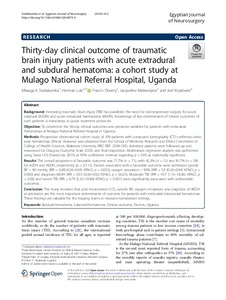Thirty-day clinical outcome of traumatic brain injury patients with acute extradural and subdural hematoma: a cohort study at Mulago National Referral Hospital, Uganda
Joel Kiryabwire; Herman Lule; Francis Olweny; Jacqueline Mabweijano; Mbaaga K. Ssebakumba
https://urn.fi/URN:NBN:fi-fe2021042826380
Tiivistelmä
Background
Increasing traumatic brain injury (TBI) has paralleled the need for decompression surgery for acute subdural (ASDH) and acute extradural haematoma (AEDH). Knowledge of key determinants of clinical outcomes of such patients is mandatory to guide treatment protocols.
Objective
To determine the 30-day clinical outcomes and predictor variables for patients with extra-axial hematomas at Mulago National Referral Hospital in Uganda.
Methods
Prospective observational cohort study of 109 patients with computed tomography (CT) confirmed extra-axial hematomas. Ethical clearance was obtained from the School of Medicine Research and Ethics Committee of College of Health Sciences, Makerere University (REC REF. 2018-185). Admitted patients were followed-up and reassessed for Glasgow Outcome Scale (GOS) and final disposition. Multivariate regression analysis was performed using Stata 14.0 (StataCorp. 2015) at 95% confidence interval, regarding p < 0.05 as statistically significant.
Results
The overall proportion of favorable outcome was 71.7% (n = 71), with 42.3% (n = 11) and 81.7% (n = 58) for ASDH and AEDH, respectively (p = 0.111). Factors associated with a favorable outcome were admission systolic BP > 90 mmHg [IRR = 0.88 (0.26–0.94) 95%CI, p = 0.032), oxygen saturation > 90% [IRR = 0.5 (0.26–0.94) 95%CI, p = 0.030] and diagnosis AEDH [IRR = 0.53 (0.30–0.92) 95%CI, p = 0.025). Moderate TBI [IRR = 4.57 (1.15–18.06) 95%CI, p = 0.03] and severe TBI [IRR = 6.79 (2.32–19.86) 95%CI, p < 0.001] were significantly associated with unfavorable outcomes.
Conclusion
The study revealed that post resuscitation GCS, systolic BP, oxygen circulation, and diagnosis of AEDH at admission are the most important determinants of outcome for patients with extra-axial intracranial hematomas. These findings are valuable for the triaging teams in resource-constrained settings.
Kokoelmat
- Rinnakkaistallenteet [19204]
